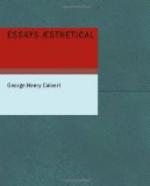Do what we will, poetic translation is brought about more from without than from within, and hence there is apt to be a dryness of surface, a lack of that sheen, that spontaneous warm emanation, which, in good original work, comes from free inward impulsion. To counteract, in so far as may be, this proneness to a mechanical inflexibility, the translator should keep himself free to wield boldly and with full swing his own native speech. By his line-for-line allegiance, Mr. Longfellow forfeits much of this freedom. He is too intent on the words; he sacrifices the spirit to the letter; he overlays the poetry with a verbal literalness; he deprives himself of scope to give a billowy motion, a heightened color, a girded vigor, to choice passages. The rhythmical languor consequent on this verbal conformity, this lineal servility, is increased by a frequent looseness in the endings of lines, some of which on every page, and many on some pages, have—contrary to all good usage—the superfluous eleventh syllable. Milton never allows himself this liberty, nor Mr. Tennyson in epic verse so little pretentious as “Idyls of the King.” Nor do good blank-verse translators give in to it. Cowper does not in his Iliad, nor Lord Derby, nor Mr. Bryant in his version of the fifth book of the Odyssey, nor Mr. Carey in his Dante. Permissible at times in dramatic blank verse, it is in epic rejected by the best artists as a weakness. Can it be that Mr. Longfellow hereby aims to be more close to the form of Dante? Whatever the cause of its use, the effect is still farther to weaken his translation. These loose poetic endings—and on most pages one third of the lines have eleven syllables and on some pages more than a third—do a part in causing Mr. Longfellow’s Dante to lack the clean outline, the tonic ring, the chiseled edge of the original, and in making his cantos read as would sound a high passionate tune played on a harp whose strings are relaxed.
Looking at the printed Italian Dante beside the English, in a volume where opposite each English page is the corresponding page of the original, as in Mr. Dayman’s, one cannot fail to be struck with the comparative narrowness of the Italian column. This comes of the comparative shortness of Italian syllables. For instance, as the strongest exemplification, the ever-recurring and, and the often-repeated is, are both expressed in Italian by a single letter, e. And this shortness comes of the numerousness of vowels. In lines of thirty letters Dante will have on an average sixteen consonants to fourteen vowels, nearly half and half; while his translators have about twenty consonants to ten vowels, or two to one. From this comparative rejection of consonants, Italian cannot, as English can, bind into one syllable words of seven or eight letters, like friends and straight, nor even words of six letters, like chimed, shoots, thwart, spring; nor does Italian abound




